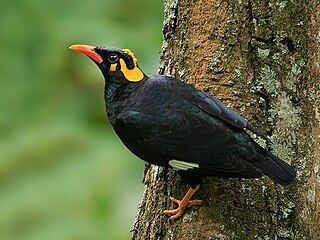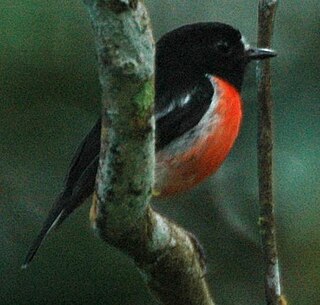
The southern hill myna is a member of the starling family. It is a resident of the forested regions of south India and Sri Lanka. This species moves around in flocks in the forest, and members of a flock keep in contact with a wide range of vocalizations.

The South Island robin is a sparrow-sized bird found only in New Zealand, where it has the status of a protected endemic species. The birds are sparsely distributed through the South Island and Stewart Island/Rakiura, although the distribution is not continuous. The nominate, and the Stewart Island robin are the two subspecies. The species is closely related to the North Island robin, and also to the extremely rare black robin of the Chatham Islands.

Bendire's thrasher is a medium-sized species of thrasher native to the southwestern United States and northwestern Mexico. It is 23–28 centimetres (9.1–11.0 in) long, with a long tail and a medium-sized bill. Coloration is grayish-brown on its upperparts with paler, faintly dark streaked underparts. The base of the lower bill is often pale, the eyes are bright yellow, and the tips of the tail are white-tipped.

The scarlet robin is a common red-breasted Australasian robin in the passerine bird genus Petroica. The species is found on continental Australia and its offshore islands, including Tasmania. The species was originally split in 1999 by Schodde and Mason, and as the original collection by Gmelin was from Norfolk Island, this retained the name of multicolor, and is now known as the Norfolk robin.

The Huon astrapia, also known as Rothschild's astrapia, Huon bird-of-paradise, or Lord Rothschild's bird-of-paradise, is a species of bird-of-paradise belonging to the genus Astrapia. Like most of its congeners, A. rothschildi is a rather elusive member of its genus and family.

Drepanornis is a genus of bird-of-paradise found in forests of New Guinea. They have long decurved sickle-like bills and an overall brown plumage.

The Splendid astrapia is a species of Astrapia of the birds-of-paradise family, Paradisaeidae, and one of the least known and most elusive of its family and genus.
The fire-maned bowerbird is a medium-sized, approximately 27 cm (11 in) long, bowerbird that inhabits and endemic to the forests of the Adelbert Range in Papua New Guinea. The striking male is black with fiery orange crown and upperback, elongated neck plumes, yellow iris and golden yellow wing patch. The female is a brown bird with brown-barred whitish underparts.

The Tibetan rosefinch, also known as Roborovski's rosefinch, is a species of rosefinch in the finch family Fringillidae. It is sometimes placed in the monotypic genus Kozlowia. It is endemic to the Tibetan Plateau. Its natural habitat is montane tundra.

The red-capped crombec is a species of African warbler, formerly placed in the family Sylviidae.

The semicollared hawk is a rare bird of prey species in the family Accipitridae. It is found in Colombia, Ecuador, Peru, and Venezuela. Its natural habitat is subtropical or tropical moist montane forests. It is potentially being affected by habitat loss.

The buff-breasted mountain tanager is a species of Neotropical bird in the tanager family Thraupidae.

The yellow-crowned euphonia is a species of bird in the family Fringillidae. It is found in Costa Rica, Nicaragua, and Panama, and is perhaps the most common euphonia in its range. Its natural habitats are subtropical or tropical dry forest, subtropical or tropical moist lowland forest, and heavily degraded former forest. It can be found on occasion in the canopy of small forests.

The olive-green tanager is a species of bird in the family Mitrospingidæ. It is endemic to Brazil.

The pink robin is a small passerine bird native to southeastern Australia. Its natural habitats are cool temperate forests of far southeastern Australia. Like many brightly coloured robins of the family Petroicidae, it is sexually dimorphic. Measuring 13.5 cm (5.3 in) in length, the robin has a small, thin, black bill, and dark brown eyes and legs. The male has a distinctive white forehead spot and pink breast, with grey-black upperparts, wings and tail. The belly is white. The female has grey-brown plumage. The position of the pink robin and its Australian relatives on the passerine family tree is unclear; the Petroicidae are not closely related to either the European or American robins, but appear to be an early offshoot of the Passerida group of songbirds.

The rose-throated tanager is a medium-sized songbird in the family Cardinalidae, the cardinals or cardinal grosbeaks. Endemic to the Yucatán Peninsula in Central America, it is found in Belize, Guatemala, and Mexico. The male has greyish plumage with a deep rose throat and crown, while the female is similar but for a yellow crown and throat.

The least honeyguide is a small species of bird in the family Indicatoridae. It is found in sub-Saharan Africa.

The Pacific robin, is a red-breasted Australasian robin in the passerine bird genus Petroica found in Melanesia and Polynesia. It is similar in plumage to the scarlet robin of Australia, and until recently the two were considered conspecific until split in 1999 by Schodde and Mason. Thirteen subspecies of Pacific robin are currently recognised, and these subspecies display considerable variation in plumage, foraging preferences, and habitat. The Norfolk robin was previously considered a subspecies of the Pacific robin, but is now considered a distinct species.

The Central Range sub-alpine grasslands is a montane grasslands and shrublands ecoregion on the island of New Guinea. The ecoregion covers the highest-elevation portions of the New Guinea Highlands, which extend along the spine of the island. The high elevations support rare tropical sub-alpine and alpine habitats, including many endemic plants and animals.
xeno-canto is a citizen science project and repository in which volunteers record, upload and annotate recordings of bird calls and sounds of orthoptera and bats. Since it began in 2005, it has collected over 575,000 sound recordings from more than 10,000 species worldwide, and has become one of the biggest collections of bird sounds in the world. All the recordings are published under one of the Creative Commons licenses, including some with open licences. Each recording on the website is accompanied by a spectrogram and location data on a map displaying geographical variation.



















